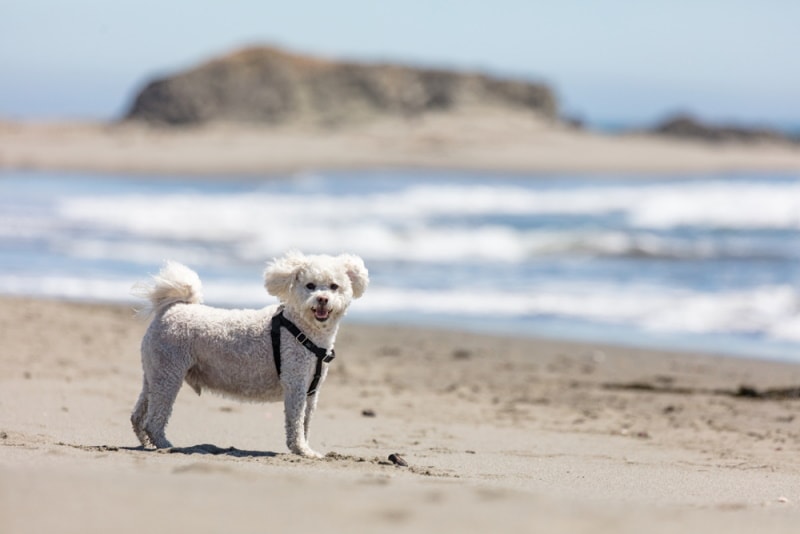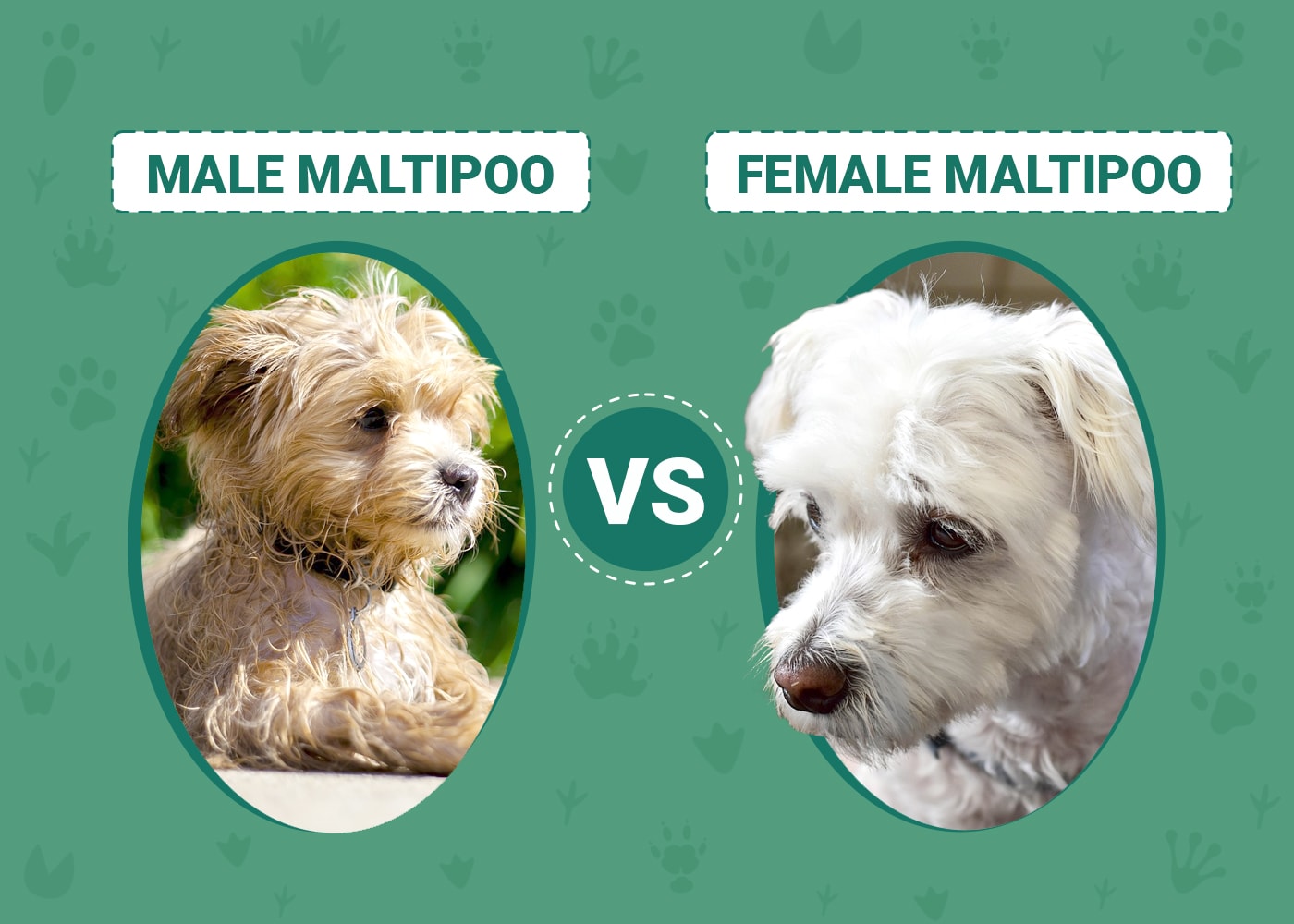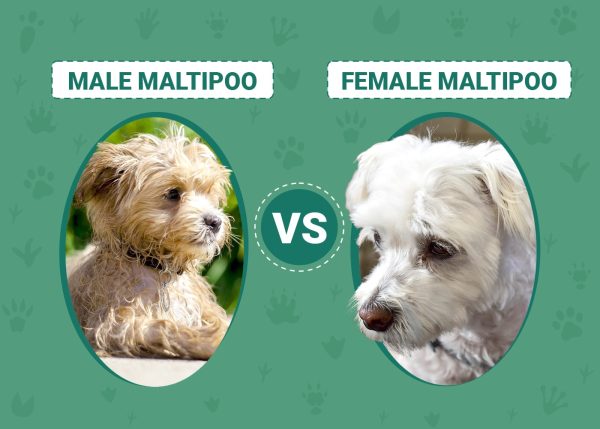Click to Skip Ahead
Most dog breeds display certain differences between the sexes, such as size and temperament. Sometimes, these differences can be so pronounced that one sex can be clearly more favorable for a specific purpose—for example, as a police dog or, in this case, a new pet for the home.
When it comes to Maltipoos, their cuteness and winning personalities are not at all affected by gender, and we think that you’d be just as happy whether you end up with a male or a female. There are, however, some differences between the sexes. Their new home environment or your particular preferences may dictate that one or the other sex may be the better personal choice.
Read on to find out what the main differences are so that you can better decide which one is right for you.
Visual Differences

At a Glance
Male Maltipoos
| Teacup | Toy | Miniature | |
| Average height (adult): | 5–6 inches | 8–10 inches | 12–15 inches |
| Average weight (adult): | 4–5 pounds | 6–10 pounds | 10–25 pounds |
Female Maltipoos
| Teacup | Toy | Miniature | |
| Average height (adult): | 5–6 inches | 8–10 inches | 12–15 inches |
| Average weight (adult): | 4–5 pounds | 6–10 pounds | 10–25 pounds |
Note: Maltipoos that come from reputable and conscientious breeders will usually display little or no difference in size between males and females. However, in certain crosses, males can be bigger than females by an average of 10%.
Maltipoo 101

Maltipoos are a delightful hybrid breed derived by crossing a Maltese with a Poodle. Known as a designer dog, the actual size and appearance of a Maltipoo can vary greatly depending on the kind of Poodle used in the cross. Maltipoos come in almost every color or combination thereof, and their coats can be curly, scruffy, or just slightly wavy.
They are universally well-loved because of their cheerful, loving, and easy-going personalities. Maltipoos are agreeable and obliging little dogs that just want to please their humans, with whom they form devoted bonds. They are likely to become just as fond of other household members, two-legged and four-legged alike. Their pleasing personalities make them a great choice of a doggie for homes with children and other pets. They would be equally happy charging around non-stop in a bustling home, or curled up quietly on Granny’s lap every day.
Maltipoos are highly intelligent pups that are easy to train. They enjoy being active, but probably won’t climb the walls if they miss their daily walks. Though they may not need as much work as some other breeds, they are likely to experience separation anxiety if left alone for too long. They can be quite vocal about their likes and dislikes, too.
They fit the “small dog” category, with the biggest of them usually not exceeding 20 pounds. Add to this their status as low shedders and hypoallergenic dogs (though, in truth, no dog can be 100% hypoallergenic), and you’ve got the perfect pet pooch in one cute little package!
Male Maltipoo Overview

Personality / Character
Male Maltipoos have a reputation for being more affectionate than females. This can mean that a male might form a more devoted and loyal bond with his owner than a female might. They will lap up endless love and cuddles but probably won’t become annoyingly pushy or needy for more when the moment is over.
The male Maltipoo is generally more energetic than the female and frequently maintains a fun-loving, puppy-like attitude well into adulthood.
The boys tend to have a more consistently happy disposition, and their even temperament makes them very appealing.
Training
Male Maltipoos are particularly fond of their grub and are, therefore, very responsive to food-centred reward systems. This, coupled with their love of being active, makes them easy to work with and train. Bear in mind, though, that his joyful zest and occasional exuberance can make him more easily distracted, and it may be necessary to exercise patience with the little man.
Health & Care
As a hybrid, or crossbreed, Maltipoos tend to be more robust and healthier than certain pure breeds. Nevertheless, there are some conditions that Maltipoos of both sexes may be predisposed to due to their breeding, such as dental problems, allergies, patellar luxation, and White Shaker Syndrome (often, but not only, found in white dogs), to name a few.
As with most species of animal, there are some gender-specific ailments and conditions to be aware of. For example, males could be at risk of developing prostate cancer and intact males could be susceptible to testicular cancer. The latter can be avoided altogether by sterilization by neutering. Neutered dogs tend to live longer and often healthier lives than intact males.

Breeding
As the boy puppy Maltipoo approaches puberty, he will begin developing sexual and territorial habits, such as humping, lifting his leg to urinate, and territory marking in the same way. If he is left intact for too long after puberty, these behaviors may persist, become annoying, and be difficult to remedy. Intact males might also become aggressive towards other male dogs.
Unless you are planning to breed with your boy, it might be advisable to consider neutering at around 6–9 months of age, or whenever the pup is fully grown.
Neutering is a cheaper procedure and relatively minor compared to spaying of females. Recovery from the general anesthetic is the most significant part of the operation. Apart from some tenderness around the procedure site for about a week, the little guy can continue his daily doings as normal once he has fully recovered from the anesthetic.
- Affectionate
- More easy-going
- More loyal
- Even-tempered
- Territorial leg lifting in unneutered males, or in those neutered later
- More easily distracted
- Intact males may become aggressive
Female Maltipoo Overview

Personality / Character
The female Malitpoo can be a much more independent pooch than the male. For this reason, she may come across as aloof and moody at times. Being a female in possession of all of those lady hormones, she may well be moody occasionally. But true to her breed, and hormones aside, she is still an affectionate little cutey.
She is still capable of forming that special bond with her chosen human, but she probably won’t need the constant affirmation and attention that her male litter mate might. A female Maltipoo may become even more territorial than a male might, regardless of whether she is spayed or not. This may result in her becoming aggressively protective over her space or her human. To counteract this, it’s important not to spoil her or indulge in this behavior as a youngster.
She is likely to have a calmer, less excitable demeanor than a male might.
Training
The female Maltipoo’s intelligence and more focused disposition make her easier to train, since she is less likely to be distracted by happenings around her. Some days, you may find yourself having to contend with grumpiness, while on other days, you may find her a little stubborn—but the majority of the time, she will be a delight.
This up-and-down behavior is not necessarily unique to female Malitpoos, but is exhibited by many female dogs of different breeds. If you accept this as normal behavior, you and Madame Maltipoo will get along beautifully!
Health & Care
Maltipoos are not a breed that exhibit a prevalence of health issues—they are generally healthy if well cared for. Apart from the previously mentioned conditions that both sexes of the breed are sometimes susceptible to, female Maltipoos might additionally be at risk of developing mammary and uterine cancer, as well as uterine infections.
Getting your female Maltipoo spayed will remove the chance of her getting uterine cancer. If she is spayed before her first heat, her chances of developing mammary cancer are reduced to 0.5%. If spaying is delayed until she is older than two and a half years old, then the preventative benefits of the procedure are negated.
Spaying is a significantly more expensive intervention than neutering, and is a major surgical procedure. The little lady will not only have a general anesthetic from which to recover, she will also be very tender for a week to 10 days as she heals.
To ensure that the female Maltipoo is less susceptible to uterine infections, it is important that she has access to plenty of fresh water at all times, has a healthy balanced diet, and can relieve herself comfortably whenever she needs to.

Breeding
There are significant benefits to be gained by spaying your female Maltipoo, so unless you are planning to breed her, it would be a good idea to do this before her first heat. The first heat happens on average when the Malitipoo is six months old—but it can be earlier or later. It is important to be extra vigilant when Madame Maltipoo is in heat to avoid an unwanted pregnancy.
As well as being beneficial in preventing cancer development, spaying may also help counteract the development of aggressive territorial behaviors.
Female Maltipoos are more susceptible to dystocia, mainly because of their diminutive size. If you plan to breed with your little lady, ensure that the chosen sire (male suitor/mate) is not too large. A large sire could result in puppies that are too large to comfortably pass through the birth canal. The mama Multipoo would also need to be monitored carefully throughout her pregnancy for other signs of potential dystocia. In severe cases, the pups would be delivered via a Caesarian section.
- Easier to train
- More intelligent
- Independent
- Less excitable
- Moodier
- Stubborn
- Territory marking may persist regardless of sterilization status
Which Gender is Right For You?
You can’t go wrong with either a boy or a girl Maltipoo. They are equally adorable, but some minor differences might sway you towards one or the other. For example, a male Maltipoo may be a better choice for a busy home with young kids and other pets, while a female Maltipoo might suit a quieter, single-person or couple’s home.
Some folks are instinctively drawn towards a particular sex when it comes to dogs. That makes it an easy decision. For the rest of us, the best way to decide would be to weigh up the subtle pros and cons, and then set up a meeting with the pups. If you’ve decided on a particular gender, then that will simplify your choices right away, and you’ll just have to see which little boy or girl pup tells you to take them home.
Having said that, you might have unequivocally settled on a gender, only to have your careful plans ruined at the pup meet and greet. Just one look can be all it takes to know that a particular fur baby is the new family member, which may not be the sex you originally decided on. Sometimes, the best-laid plans are thwarted by the pull of the heartstrings!
Featured Image Credit: Top – MrKawa, Shutterstock | Bottom – Heidi Bollich, Shutterstock












